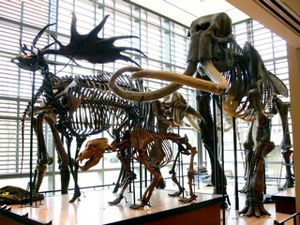Beneski Museum of Natural History facts for kids

Mammals of the Ice Age in the Main Hall
|
|
| Location | Amherst, Massachusetts |
|---|---|
The Beneski Museum of Natural History is a cool place to explore fossils, rocks, and ancient artifacts! It's located at Amherst College in Amherst, Massachusetts. This museum shows off amazing collections of fossils and minerals. Many of these were found by students and teachers from the college, both from nearby areas and from all over the world. The museum is inside the Beneski Earth Sciences Building, which was finished in 2006. It's also part of a group called Museums10, which connects ten museums in the area.
Contents
Discovering the Past: Museum History
The Beneski Museum's collection started way back when Amherst College first opened. Edward Hitchcock, a professor who later became the college's third president (from 1845 to 1854), loved science. He encouraged former students to send him interesting scientific items from around the globe.
Early Homes for Collections
During his time as president, Hitchcock helped raise money to build a special place called the Octagon. This was the very first home for Amherst's natural history collection. Later, in 1855, the college built the Appleton Cabinet. This building was made possible by a gift from Samuel Appleton. It housed important collections like the Hitchcock Ichnological Cabinet (a collection of dinosaur footprints), the Gilbert Museum of Indian Relics, and the Adams Zoological Museum.
Moving to New Buildings
The college's collections moved a few times over the years. In the 1940s, they moved into the old Pratt Gymnasium. This new home was then called the Pratt Museum of Natural History. Finally, in 2006, the entire collection moved to its current, modern home in the Beneski Earth Sciences Building.
Amazing Discoveries
Today, the museum holds about 200,000 objects! This includes the famous Hitchcock Ichnological Cabinet. It has more than 1,700 slabs of rock with dinosaur footprints. This is one of the biggest collections of its kind in the world. Many of these footprints were collected by Edward Hitchcock himself.
The collection also features the world-famous "Noah's Raven" tracks. These tracks were found in South Hadley, Massachusetts, in 1802. They are the first dinosaur fossil ever collected in North America! This happened 40 years before scientists even realized dinosaurs were a unique group of ancient animals. Scientists from all over the world visit the museum to study these incredible collections.
Exploring the Collections
The Beneski Museum of Natural History has many different types of collections and exhibits. These include fossils of animals with backbones (like dinosaurs) and animals without backbones (like insects). It also has minerals, other types of rocks, and items from ancient human cultures. The museum has three floors of exhibits with over 1,700 items on display. It is home to the world's largest collection of dinosaur tracks, known as the Hitchcock Ichnological Cabinet, which dates back to the 1850s.
Who Collected These Treasures?
People have been collecting specimens for the museum since the 1830s. They found items both locally and from far-off places around the world. Some famous collectors include Edward Hitchcock, Charles Shepard (who graduated from Amherst College in 1824), and Frederick Loomis, an Amherst professor in the early 1900s.
What You Can See on Each Floor
- First Floor: Here you'll find huge Ice Age mammals. This includes a mastodon found by Shepard in 1869 and a mammoth discovered by Loomis in 1923. This floor also has an exhibit showing how horses evolved in North America.
- Second Floor: This floor displays many different invertebrates (animals without backbones). You'll also see trace fossils (like tracks or burrows), minerals, and exhibits about the local geology. Many displays on these two floors show how life has changed over time and how living things interact with their environment.
- Basement: The basement is where the amazing collection of dinosaur tracks (ichnology) is kept. You can also see dinosaur skeletons here. This includes the best-preserved Dryosaurus specimen in the world. There are also two legs from the giant long-necked dinosaur Dyslocosaurus. The museum also has a jawbone from "Alamotyrannus", which was found in 1924.
The Beneski Building: A Home for Science
The Beneski Earth Sciences Building opened in 2006. It houses both the geology program and the Beneski Museum of Natural History. The building was designed by Payette Associates. It covers about 55,800 square feet (5,184 square meters). Its design fits in well with other buildings nearby, like Fayerweather Hall.
Award-Winning Design
This building has won more architectural awards than any other building at Amherst College. It received the 2007 American Institute of Architects New England Chapter Honor Award for Design Excellence. It also won the 2008 Best in Class Brick in Architecture Award in the Educational Building category.
Learning Through Exploration
The building's design helps students learn science by doing. Many regular classrooms were replaced with teaching labs. These labs combine different research activities in one space. They also make it easy for students to access the museum's huge collections. This way, students can actively take part in scientific research.
Cool Building Features
The building's south side faces the Holyoke Range. This allows students to study the interesting rock formations there. The landscaping around the building includes 35 tons of rocks brought from the Adirondack Mountains. Even the bathroom countertops are special! They are made of different types of rocks on each floor: igneous rocks on one level, metamorphic rocks on another, and sedimentary rocks on a third.
See also

